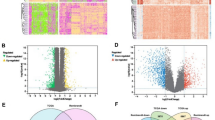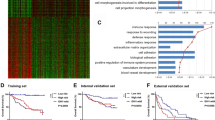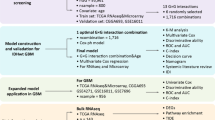Abstract
Purpose
Glucose-6-phosphate dehydrogenase (G6PD) is a key enzyme preventing cells from oxidative damage and has been reported to have tumor-promoting roles. This study aims to comprehensively evaluate the predictive values of G6PD on brain tumor risk, prognosis and chemo-resistance.
Methods
A retrospective 13-year cohort study analyzing cancer risk using the Taiwan National Health Insurance Research Database (4066 G6PD deficiency patients and 16,264 controls) was conducted. Furthermore, RNAseq and clinical data of grade II–III glioma (LGG, n = 515) and glioblastoma (GBM, n = 155) were downloaded from The Cancer Genome Atlas (TCGA) and analyzed. Bioinformatics methods were applied to build a glioma prognostication model and to predict response to chemotherapy based on tumor G6PD-related gene expressions. The predicted results were validated in another glioma cohort GSE 16011 and in KALS1 cell line.
Results
G6PD-dificient patients were found to have an increased risk for cancers, especially for brain tumor (adjusted hazard ratio (HR) 10.5, 95% CI 1.03–7.60). Furthermore, higher tumor G6PD expression was associated with poor patient survival in LGG, but not in GBM. A prognostication model using expression levels of G6PD and 9 related genes (PSMA2, PSMB8, SHFM1, GSS, GSTK1, MGST2, POLD3, MSH2, MSH6) could independently predict LGG patient survival. Boosted decision tree analysis on 213 cancer cell line database revealed predictive values of G6PD expression on response to gemcitabine and bortezomib. Knockdown of G6PD in KALS1 cell line enhanced its sensitivity to both chemotherapeutic agents.
Conclusions
Our study suggests that G6PD could be a marker predicting glioma risk, prognosis and chemo-sensitivity.



Similar content being viewed by others
References
Stanton RC (2012) Glucose-6-phosphate dehydrogenase, NADPH, and cell survival. IUBMB Life 64(5):362–369
Jeng W, Loniewska MM, Wells PG (2013) Brain glucose-6-phosphate dehydrogenase protects against endogenous oxidative DNA damage and neurodegeneration in aged mice. ACS Chem Neurosci 4(7):1123–1132
Mejias R, Villadiego J, Pintado CO, Vime PJ, Gao L, Toledo-Aral JJ, Echevarria M, Lopez-Barneo J (2006) Neuroprotection by transgenic expression of glucose-6-phosphate dehydrogenase in dopaminergic nigrostriatal neurons of mice. J Neurosci 26(17):4500–4508
Ramao A, Gimenez M, Laure HJ, Izumi C, Vida RC, Oba-Shinjo S, Marie SK, Rosa JC (2012) Changes in the expression of proteins associated with aerobic glycolysis and cell migration are involved in tumorigenic ability of two glioma cell lines. Proteome Sci 10(1):53
Benfeitas R, Uhlen M, Nielsen J, Mardinoglu A (2017) New challenges to study heterogeneity in cancer redox metabolism. Front Cell Dev Biol 5:65
Dore MP, Davoli A, Longo N, Marras G, Pes GM. Glucose-6-phosphate dehydrogenase deficiency and risk of colorectal cancer in Northern Sardinia: A retrospective observational study. Medicine (Baltimore) 2016;95(44):e5254
Chien YH, Lee NC, Wu ST, Liou JJ, Chen HC, Hwu WL (2008) Changes in incidence and sex ratio of glucose-6-phosphate dehydrogenase deficiency by population drift in Taiwan. Southeast Asian J Trop Med Public Health 39(1):154–161
Rinaldi M, Caffo M, Minutoli L, Marini H, Abbritti RV, Squadrito F, Trichilo V, Valenti A, Barresi V, Altavilla D, Passalacqua M, and Caruso G. ROS and brain gliomas: an overview of potential and innovative therapeutic strategies. Int J Mol Sci. 2016;17(6)
Jiang P, Du W, Wu M (2014) Regulation of the pentose phosphate pathway in cancer. Protein Cell 5(8):592–602
Zhang C, Zhang Z, Zhu Y, Qin S (2014) Glucose-6-phosphate dehydrogenase: a biomarker and potential therapeutic target for cancer. Anticancer Agents Med Chem 14(2):280–289
Furuta E, Okuda H, Kobayashi A, Watabe K (2010) Metabolic genes in cancer: their roles in tumor progression and clinical implications. Biochim Biophys Acta 1805(2):141–152
Stupp R, Brada M, van den Bent MJ, Tonn JC, Pentheroudakis G, Group EGW (2014) High-grade glioma: ESMO Clinical Practice Guidelines for diagnosis, treatment and follow-up. Ann Oncol 25(Suppl 3):iii93-101
Cohen AL, Holmen SL, Colman H (2013) IDH1 and IDH2 mutations in gliomas. Curr Neurol Neurosci Rep 13(5):345
Fack F, Tardito S, Hochart G, Oudin A, Zheng L, Fritah S, Golebiewska A, Nazarov PV, Bernard A, Hau AC, Keunen O, Leenders W, Lund-Johansen M, Stauber J, Gottlieb E, Bjerkvig R, Niclou SP (2017) Altered metabolic landscape in IDH-mutant gliomas affects phospholipid, energy, and oxidative stress pathways. EMBO Mol Med 9(12):1681–1695
Chaichana KL, McGirt MJ, Laterra J, Olivi A, Quinones-Hinojosa A (2010) Recurrence and malignant degeneration after resection of adult hemispheric low-grade gliomas. J Neurosurg 112(1):10–17
Grier JT, Batchelor T (2006) Low-grade gliomas in adults. Oncologist 11(6):681–693
Kim MM, Camelo-Piragua S, Schipper M, Tao Y, Normolle D, Junck L, Mammoser A, Betz BL, Cao Y, Kim CJ, Heth J, Sagher O, Lawrence TS, Tsien CI (2016) Gemcitabine plus radiation therapy for high-grade glioma: long-term results of a phase 1 dose-escalation study. Int J Radiat Oncol Biol Phys 94(2):305–311
Ahmad F, Dixit D, Sharma V, Kumar A, Joshi SD, Sarkar C, Sen E (2016) Nrf2-driven TERT regulates pentose phosphate pathway in glioblastoma. Cell Death Dis 7:e2213
Ius T, Ciani Y, Ruaro ME, Isola M, Sorrentino M, Bulfoni M, Candotti V, Correcig C, Bourkoula E, Manini I, Pegolo E, Mangoni D, Marzinotto S, Radovic S, Toffoletto B, Caponnetto F, Zanello A, Mariuzzi L, Di Loreto C, Beltrami AP, Piazza S, Skrap M, and Cesselli D. A NF-kappaB signature predicts low-grade glioma prognosis: a precision medicine approach based on patient-derived stem cells. Neuro Oncol 2017
Lin JN, Lin CL, Lin MC, Lai CH, Lin HH, Yang CH, Sung FC, Kao CH (2015) Risk of leukaemia in children infected with enterovirus: a nationwide, retrospective, population-based, Taiwanese-registry, cohort study. Lancet Oncol 16(13):1335–1343
Lin JN, Lin CL, Yang CH, Lin MC, Lai CH, Lin HH, Kao CH (2016) Risk of Nephrotic Syndrome following Enteroviral Infection in Children: A Nationwide Retrospective Cohort Study. PLoS ONE 11(8):e0161004
Budczies J, Klauschen F, Sinn BV, Gyorffy B, Schmitt WD, Darb-Esfahani S, Denkert C (2012) Cutoff Finder: a comprehensive and straightforward Web application enabling rapid biomarker cutoff optimization. PLoS ONE 7(12):e51862
Iorio F, Knijnenburg TA, Vis DJ, Bignell GR, Menden MP, Schubert M, Aben N, Goncalves E, Barthorpe S, Lightfoot H, Cokelaer T, Greninger P, van Dyk E, Chang H, de Silva H, Heyn H, Deng X, Egan RK, Liu Q, Mironenko T, Mitropoulos X, Richardson L, Wang J, Zhang T, Moran S, Sayols S, Soleimani M, Tamborero D, Lopez-Bigas N, Ross-Macdonald P, Esteller M, Gray NS, Haber DA, Stratton MR, Benes CH, Wessels LFA, Saez-Rodriguez J, McDermott U, Garnett MJ. A landscape of pharmacogenomic interactions in cancer. Cell 2016;166(3):740–754
Felix K, Rockwood LD, Pretsch W, Nair J, Bartsch H, Bornkamm GW, Janz S (2002) Moderate G6PD deficiency increases mutation rates in the brain of mice. Free Radic Biol Med 32(7):663–673
Beaconsfield P, Rainsbury R, Kalton G (1965) Glucose-6-phosphate dehydrogenase deficiency and the incidence of cancer. Oncology 19:11–19
Chen J, Pitmon E, Wang K (2017) Microbiome, inflammation and colorectal cancer. Semin Immunol 32:43–53
Yang Z, Shen Y, Oishi H, Matteson EL, Tian L, Goronzy JJ, Weyand CM (2016) Restoring oxidant signaling suppresses proarthritogenic T cell effector functions in rheumatoid arthritis. Sci Transl Med 8(331):331ra338
Savina NV, Nikitchenko NV, Kuzhir TD, Rolevich AI, Krasny SA, Goncharova RI (2016) The cellular response to oxidatively induced DNA damage and polymorphism of some DNA repair genes associated with clinicopathological features of bladder cancer. Oxid Med Cell Longev 2016:5710403
Chwastek J, Jantas D, Lason W (2017) The ATM kinase inhibitor KU-55933 provides neuroprotection against hydrogen peroxide-induced cell damage via a gammaH2AX/p-p53/caspase-3-independent mechanism: Inhibition of calpain and cathepsin D. Int J Biochem Cell Biol 87:38–53
Wilson A, Yakovlev VA (2016) Cells redox environment modulates BRCA1 expression and DNA homologous recombination repair. Free Radic Biol Med 101:190–201
Shahid M, Cho KM, Nguyen MN, Choi TG, Jo YH, Aryal SN, Yoo JY, Yun HR, Lee JW, Eun YG, Lee JS, Kang I, Ha J, Yoon HJ, Kim SY, Kim SS (2016) Prognostic value and their clinical implication of 89-gene signature in glioma. Oncotarget 7(32):51237–51250
Wang ZL, Zhang CB, Cai JQ, Li QB, Wang Z, Jiang T (2015) Integrated analysis of genome-wide DNA methylation, gene expression and protein expression profiles in molecular subtypes of WHO II–IV gliomas. J Exp Clin Cancer Res 34:127
Ju HQ, Lu YX, Wu QN, Liu J, Zeng ZL, Mo HY, Chen Y, Tian T, Wang Y, Kang TB, Xie D, Zeng MS, Huang P, Xu RH (2017) Disrupting G6PD-mediated Redox homeostasis enhances chemosensitivity in colorectal cancer. Oncogene 36(45):6282–6292
Wang Z, Liang S, Lian X, Liu L, Zhao S, Xuan Q, Guo L, Liu H, Yang Y, Dong T, Liu Y, Liu Z, Zhang Q (2015) Identification of proteins responsible for adriamycin resistance in breast cancer cells using proteomics analysis. Sci Rep 5:9301
Yin X, Tang B, Li JH, Wang Y, Zhang L, Xie XY, Zhang BH, Qiu SJ, Wu WZ, Ren ZG (2017) ID1 promotes hepatocellular carcinoma proliferation and confers chemoresistance to oxaliplatin by activating pentose phosphate pathway. J Exp Clin Cancer Res 36(1):166
Huang Y, Bell LN, Okamura J, Kim MS, Mohney RP, Guerrero-Preston R, Ratovitski EA (2012) Phospho-DeltaNp63alpha/SREBF1 protein interactions: bridging cell metabolism and cisplatin chemoresistance. Cell Cycle 11(20):3810–3827
Fack F, Espedal H, Keunen O, Golebiewska A, Obad N, Harter PN, Mittelbronn M, Bahr O, Weyerbrock A, Stuhr L, Miletic H, Sakariassen PO, Stieber D, Rygh CB, Lund-Johansen M, Zheng L, Gottlieb E, Niclou SP, Bjerkvig R (2015) Bevacizumab treatment induces metabolic adaptation toward anaerobic metabolism in glioblastomas. Acta Neuropathol 129(1):115–131
Mani A, Gelmann EP (2005) The ubiquitin-proteasome pathway and its role in cancer. J Clin Oncol 23(21):4776–4789
Odia Y, Kreisl TN, Aregawi D, Innis EK, Fine HA (2015) A phase II trial of tamoxifen and bortezomib in patients with recurrent malignant gliomas. J Neurooncol 125(1):191–195
Raizer JJ, Chandler JP, Ferrarese R, Grimm SA, Levy RM, Muro K, Rosenow J, Helenowski I, Rademaker A, Paton M, Bredel M (2016) A phase II trial evaluating the effects and intra-tumoral penetration of bortezomib in patients with recurrent malignant gliomas. J Neurooncol 129(1):139–146
Veldhuijzen van Zanten SEM, El-Khouly FE, Jansen MHA, Bakker DP, Sanchez Aliaga E, Haasbeek CJA, Wolf NI, Zwaan CM, Vandertop WP, van Vuurden DG, Kaspers GJL (2017) A phase I/II study of gemcitabine during radiotherapy in children with newly diagnosed diffuse intrinsic pontine glioma. J Neurooncol 135(2):307–315
Acknowledgements
This work was supported by the following grants. CAY received grants from the Ministry of Science and Technology (MOST), Taiwan (R.O.C.), Grant 106-2314-B-039-047-MY3, and from China Medical University Hospital, Grant DMR-107-205; and CLL received grants from the Ministry of Health and Welfare, Taiwan (R.O.C.), Grant MOHW107-TDU-B-212-123004. The authors thank Yu-Chen Ho for his technical assistance.
Funding
This work was supported by the following Grants. CAY received Grants from the Ministry of Science and Technology (MOST), Taiwan (R.O.C.), Grant 106-2314-B-039-047-MY3, and from China Medical University Hospital, Grant DMR-107-205; and CLL received Grants from the Ministry of Health and Welfare, Taiwan (R.O.C.), Grant MOHW107-TDU-B-212-123004. The funders had no role in study design, data collection and analysis, decision to publish, or preparation of the manuscript.
Author information
Authors and Affiliations
Corresponding author
Ethics declarations
Conflict of interest
The authors declare no conflict of interest.
Ethical approval
All procedures performed in studies involving human participants were in accordance with the ethical standards of the institutional research committee and with the 1964 Helsinki Declaration and its later amendments or comparable ethical standards. The study was approved by the Ethics Review Board of China Medical University and Hospital in Taiwan (CRREC-103-048(CR-3)).
Informed consent
The human data analyzed in this study were all retrieved from legal and delinked databases, the personal information could not be identified and the research was granted exemption from informed consent by the institutional research ethics committee.
Electronic supplementary material
Below is the link to the electronic supplementary material.
Rights and permissions
About this article
Cite this article
Yang, CA., Huang, HY., Lin, CL. et al. G6PD as a predictive marker for glioma risk, prognosis and chemosensitivity. J Neurooncol 139, 661–670 (2018). https://doi.org/10.1007/s11060-018-2911-8
Received:
Accepted:
Published:
Issue Date:
DOI: https://doi.org/10.1007/s11060-018-2911-8




